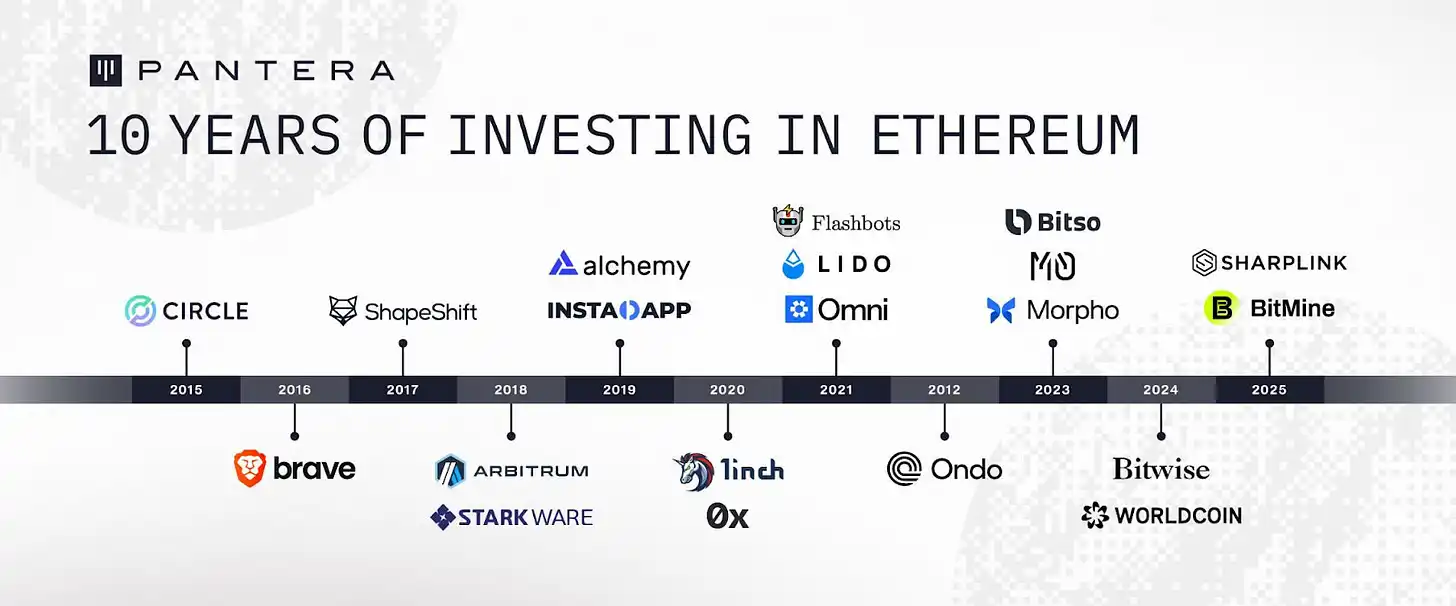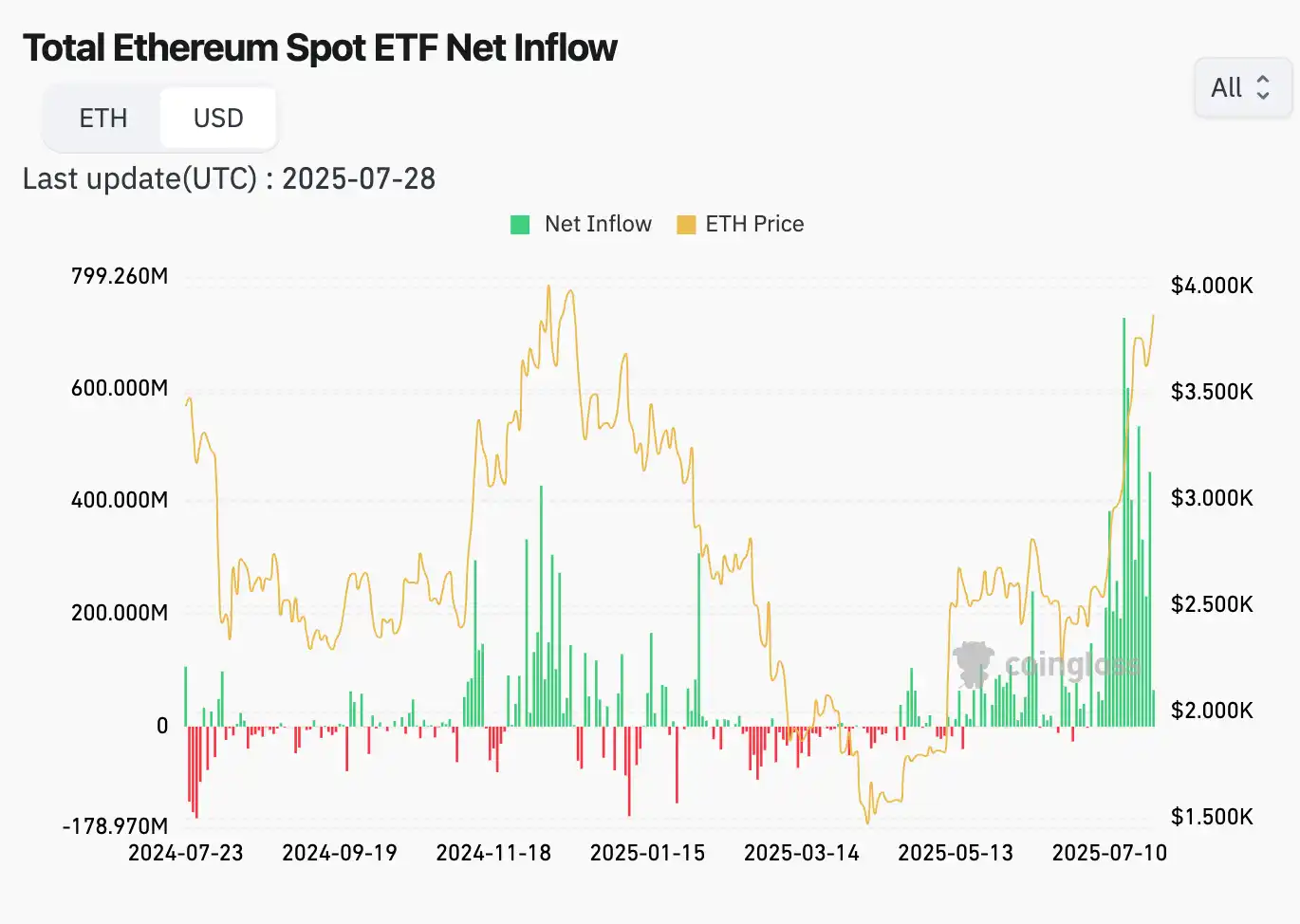Original author: Paul Veradittakit, Partner at Pantera Capital
Reprinted by: Daisy, Mars Finance
Key Takeaways
Entering its second decade, Ethereum is establishing itself as a foundational layer for stablecoins, DeFi, and tokenized assets.
Digital Asset Treasuries (DAT) are reducing token circulation and driving institutional demand for ETH, thus creating structural price support.
With regulatory clarity and reforms at the Ethereum Foundation, Ethereum will gradually become the core infrastructure of on-chain capital markets, achieving long-term growth.
The origins of Ethereum's vision
Before creating Ethereum, Vitalik Buterin was an early Bitcoin supporter and worked at Bitcoin Magazine. There, he realized Bitcoin lacked scripting capabilities to meet application development needs. Thus, he proposed a bold idea: to create Ethereum with a universal scripting language and design it to run on a decentralized, permissionless network. This idea seemed very avant-garde at the time and drew significant skepticism—after all, it was just a young man without backing from big companies trying to create a completely new technological system.
However, the key to changing the perspectives of many early investors lies in the increasing number of applications choosing to build on Ethereum rather than Bitcoin and its Layer 2, indicating that Ethereum is more suitable for application development. One of the first 'killer applications' validating this view is Augur—a decentralized prediction market. Augur showcases Ethereum's powerful potential: it can support robust applications based on transparency, automation, and financial logic while allowing developers to issue tokens, coordinate governance, and raise funds natively, directly giving rise to the ICO (initial coin offering) craze.
A decade of Ethereum
Ethereum is celebrating its tenth anniversary and is enjoying a long-awaited moment of glory.
Since its launch in 2015, Ethereum has pioneered programmable smart contracts, bringing together a developer community and laying the foundation for DeFi, gaming, and NFTs. Over the past decade, this ecosystem has continuously innovated, supporting most DeFi protocols and becoming a core pillar for stablecoins. With the maturation of stablecoin infrastructure, the introduction of the GENIUS Act has brought regulatory clarity while also introducing royalty income for Ethereum and boosting its demand.
Despite stablecoins like USDC and USDT existing on multiple chains, Ethereum remains the dominant platform for stablecoin activity, accounting for nearly 50% of the global stablecoin market cap. Ethereum's strong ecosystem continues to drive price growth underpinned by the adoption of stablecoins and innovative scalability solutions, while Pantera Capital's strategic investments have further propelled this growth momentum.
Pantera's investments in the Ethereum ecosystem

Over the past decade, Pantera Capital has consistently invested in the Ethereum ecosystem, supporting transformative projects and founders closely aligned with Ethereum's growth. Key investments include:
· Circle: The driving force behind USDC, with a market cap exceeding $60 billion, promoting the widespread adoption of Ethereum in DeFi and payments.
· Arbitrum: A leading Layer 2 solution, capturing 100% of Ethereum's new transaction growth in 2023, with transaction speeds increased by 40 times and costs reduced by 20 times, processing over 1.89 billion transactions, with decentralized exchange trading volume exceeding $54.5 billion, demonstrating Ethereum's scalability.
· Ondo: Standing out in the multi-billion dollar tokenized asset management market, launched USDY in 2023, connecting real assets like U.S. Treasuries with on-chain finance, reinforcing Ethereum's role as core infrastructure.
· Morpho: Optimizing the lending experience on Ethereum, with nearly $1 billion in deposits within a year, becoming one of the fastest DeFi protocols to reach this milestone.
· Bitwise: Pantera provided early funding support for its spot Ethereum ETF, becoming one of the first ETFs to be approved, attracting institutional capital inflow. By 2025, Bitwise will manage over $4 billion in assets, utilizing the Ethereum blockchain to drive DeFi and tokenized asset strategies.
· BitMine and other companies: Together with companies like Bit Digital, added over 840,000 ETH to corporate treasuries, showcasing Ethereum's value as a reserve asset.
Pantera Capital promotes Ethereum's core position in on-chain finance, scalability solutions, and real asset connections through strategic investments, supporting the continuous development and innovation of its ecosystem.
Institutional demand, digital asset treasuries, and changes in Ethereum's supply landscape
Ethereum surged 53% in July, and its strong rise is not merely hype but driven by structural factors: institutional investments in ETFs and digital asset treasuries (DATs), the transformation of the Ethereum Foundation, and recent clarity in the regulatory environment.
Institutional interest in crypto assets is concentrated in the ETF and DAT sectors. Last week, the U.S. spot ETH ETF attracted $1.8 billion in capital inflow, while DAT has begun to stockpile ETH on a large scale. SharpLink (SBET) increased its reserves to 361,000 ETH, and BitMine surpassed $2 billion in Ethereum holdings in just 16 days. As mentioned by Tom Lee of MicroStrategy and Cosmo Jiang of Pantera in a conference call, these asset management firms have built-in advantages: low-cost capital, equity premiums, staking yields, merger arbitrage, and operating income, allowing every new share issuance to increase their per-share ETH holdings. This unique structure continuously reduces Ethereum's circulation, providing price support that goes beyond simple demand.

Source: https://www.coinglass.com/eth-etf
DAT is no longer a novelty in the native cryptocurrency space but rather a point of entry for institutional investors into cryptocurrency and Ethereum, allowing them to gain exposure before purchasing spot or engaging in on-chain transactions. As I mentioned in a previous blog (The Wave of Crypto Projects Going Public in the U.S.: How to Reasonably Value to Attract Wall Street's Attention?), these tools concentrate enormous buying power, often absorbing more ETH than issued, driving scarcity and prompting broader capital rotation into other altcoins.
Regulatory clarity and the strategic shift of the Ethereum Foundation
The improvement in the regulatory environment is transforming past obstacles into opportunities. In July of this year, the GENIUS Act granted federally chartered status to regulated payment stablecoins. Stablecoins have quietly become a killer application for cryptocurrencies, with a circulation exceeding $250 billion, of which Ethereum has settled approximately half of the tokenized dollar transfers globally.
At the same time, the new leadership and rapid development of the Ethereum Foundation (EF) are driving rapid iterations of the chain. This transformation includes leadership restructuring, adjustments to the protocol team structure, strict treasury policies, and an accelerated technical roadmap to address community criticisms concerning efficiency, transparency, and competitiveness. By focusing on Layer 1 scalability, Blobspace (data storage space), user experience (UX) optimization, and DeFi integration, the aim is to solidify Ethereum's dominant position in institutional adoption (such as Robinhood's stock token on Arbitrum) and blockchain competition (such as Solana). Despite still facing challenges such as talent retention and community expectation management, the EF's strategic transformation lays the foundation for Ethereum to seize opportunities in the migration of capital markets on-chain, such as the emergence of innovative cases like Robinhood Chain and Pantera's ecosystem investments.
Final Thoughts
Stablecoins have finally locked onto a reliable trajectory, receiving strengthened regulatory clarity from acts such as the GENIUS Act, thereby boosting their demand. Digital asset treasuries are the engines behind this demand. They absorb market liquidity, drive up prices, and provide institutions with a one-stop solution for holding crypto assets. In today's market, which places more emphasis on structural yields, tokens with deflationary pressure and linked to real cash flows will become ideal underlying assets for DATs. This trend will further drive up Ethereum's price, while demand for the Ethereum blockchain will also surge.
We are at a critical moment of significant infrastructure transformation, which requires not a magic bullet but a series of solutions capable of addressing numerous thorny issues. At Pantera Capital, we are always committed to investing in solutions that can empower the next phase of on-chain capital markets, simplify financial infrastructure, and expand the horizon of blockchain innovation. Ethereum is at the center of this transformation; it is the core pillar of stablecoins, a favored platform for institutions, and a catalyst for the continuous development of the digital asset economy, leading the industry toward a new future.
